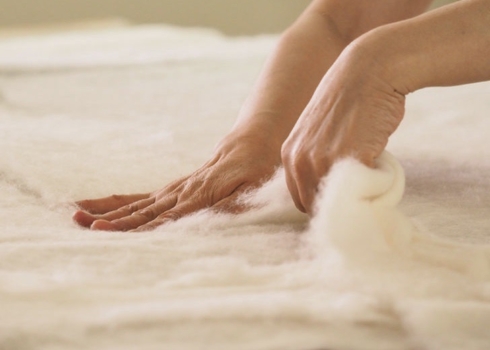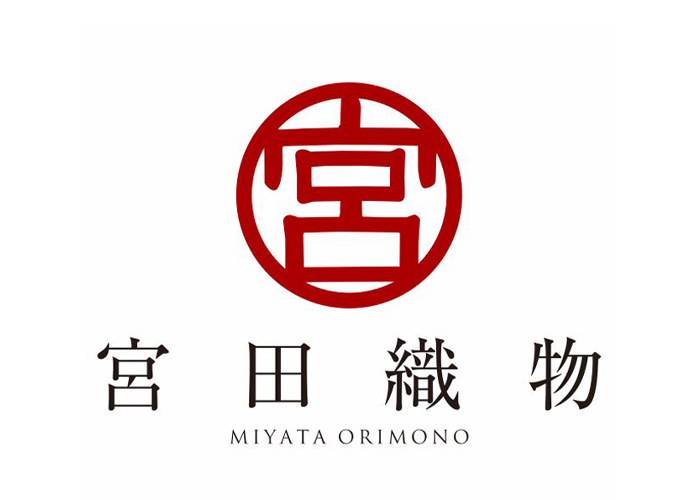HANTEN: Japanese style short coat
HANTEN is a traditional workwear like a warm Japanese style short coat or jacket. It used to be worn over a kimono. Each piece is handcrafted by Miyata Orimono craftsmen, who have been making HANTEN in Chikugo City, Fukuoka Prefecture, for more than half a century. Miyata Orimono makes sure that each HANTEN is sewn and finished by hand, as a sewing machine would destroy the volume of the cotton. Besides, they change the width of the needlework according to the strength required for each part of the HANTEN and plump up the area around the collar. All these detailed processes give your HANTEN its special comfort. It is a loose-fitting HANTEN based on its traditional shape. It is soft and fitted, with a string tie in the front and a pocket on each side.
*Although this product has been manufactured based on the dimensions shown, the actual dimensions of the finished product may vary slightly due to hand sewing.

Cotton Wadding Made From Natural Fibers
This HANTEN is made of 80% natural cotton wadding and 20% polyester wadding. Natural cotton wadding has voids in its fibers that retain heat and resist static electricity. In addition, the polyester wadding is blended in an exquisite ratio that compensates for the puffiness of the cotton wadding without compromising the quality of the cotton wadding. This air-filled wadding allows vapor to escape as you sweat. It keeps you comfortable all day long because natural cotton circulates human body heat.

How to Make a HANTEN?
Working in pairs, they rhythmically stuff the wadding into the HANTEN in an exquisite combination, without speaking aloud. Because the sheets of wadding are piled up and stuffed by hand, the wadding can be carefully placed in every corner, including the back and the hem. With proper care, these HANTEN can be used for a long time and will gradually adapt to your body.

Stitch-by-Stitch, Hand Stitching.
Miyata Orimono makes sure that each HANTEN is sewn and finished by hand, as a sewing machine would destroy the volume of the cotton. They also change the width of the stitching according to the strength required for each part of the HANTEN and plump up the area around the collar. All these details add to the comfort of your HANTEN.




HANTEN"LIFESTOCK" 010 (Red Checked)
Fabric producing region: Banshu (Hyogo Prefecture)
This outer fabric has a raised feel and a soft touch. The textile known as "Banshu-ori" was developed based on techniques introduced from Nishijin in Kyoto more than 200 years ago, and cotton textiles flourished in this area, which was suitable for cotton cultivation. It is characterized by yarn-dyed checks and stripes. It is also known as the famous production area of shirt fabric.

HANTEN "LIFESTOCK" 011 (Soft Denim)
Fabric producing region: Tenryusha (Shizuoka Prefecture)
The outer fabric is a thin denim with a little stretch. The region is known for producing fabrics such as corduroy and velveteen. These fabrics are ideal for hats and winter clothing. The pile yarns are cut and fluffed to produce a soft, thick, lustrous, high quality fabric. However, due to the labor-intensive manufacturing process and changes in the environment, the succession of manufacturing techniques has been threatened in recent years.

HANTEN "LIFESTOCK" 011 (Soft Denim)
Fabric producing region: Tenryusha (Shizuoka Prefecture)
The outer fabric is a thin denim with a little stretch. The region is known for producing fabrics such as corduroy and velveteen. These fabrics are ideal for hats and winter clothing. The pile yarns are cut and fluffed to produce a soft, thick, lustrous, high quality fabric. However, due to the labor-intensive manufacturing process and changes in the environment, the succession of manufacturing techniques has been threatened in recent years.

MIYATA ORIMONO
Founded in 1913, the company began with the production of "Kurume Kasuri" and in 1965 began the production of wadded hanten. At its peak, the company shipped 500,000 pieces of hanten nationwide each year. The company boasted the highest quality and production volume in Japan. Even today, the company continues to produce products with a focus on quality, from the selection of the fabric threads to the blend ratio of blended cotton.
